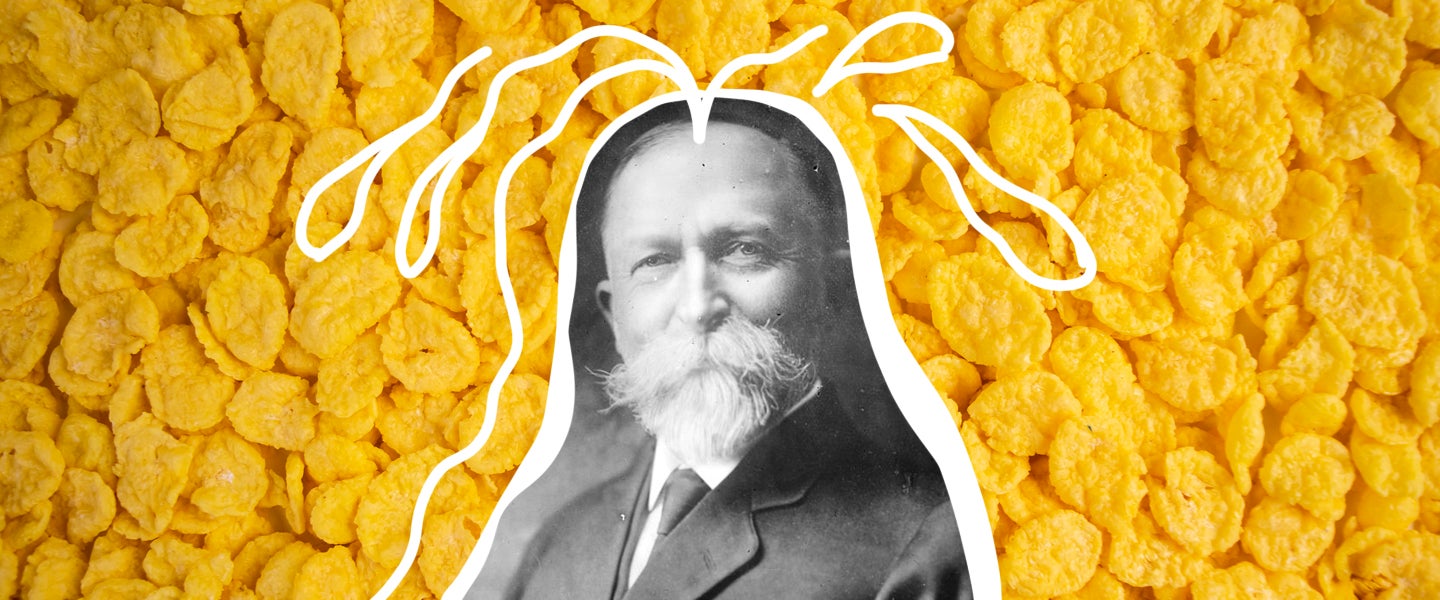Have you ever wondered who invented cheese? Or big, crusty bread? Seriously: How did anyone know to combine ground-up grains with water and yeast and put it near a fire to cook? Whose nutjob idea was that?
Speaking of nutjobs, did you know about anti-masturbation food? As it turns out, a surprising array of foods from graham crackers to Kellogg’s Corn Flakes were invented to stop people from masturbating. But while there’s no evidence that they actually worked, the circumstances under which people thought biscuits and breakfast cereal could prevent you from touching yourself are both hilarious and horrifying.
To fully understand the twisted line of thinking that lead to the development of anti-masturbation cuisine, we have to travel back in time to the 18th century. In the Western world, the Great Awakening had piqued people’s interest in science and religion, with the most popular theories combining the two. Biological determinism — the belief that biology dictates behavior — was particularly en vogue, and anything that didn’t have a directly observable biological function was deemed to be an extraneous misuse of God’s intelligent design.
Embedded in this idea was the superiority of humans over all other life forms — since we appeared to have developed large brains and opposable thumbs that allowed us to invent math and play the pan flute, it was generally accepted that we were separate from animals and any animal-like behavior was subhuman. Because masturbation appeared to have no biological purpose other than self-gratification and monkeys were observed doing it, it came to be seen not only as the ultimate moral failure, but as a disease that required medical and spiritual intervention.
This belief was codified in medical and popular literature of the time. In 1745, the British physician Robert James wrote in his book A Medicinal Dictionary that masturbation was one of the most “deplorable and generally incurable disorders” and influential German philosopher Immanuel Kant argued that the fact that it satisfied people’s animalistic drives made it an action far worse than suicide.
People had all sorts of ideas about how to intervene in the problem of “self-pollution,” but diet was a particularly popular one. Many doctors, preachers and thought leaders of the time believed that alcohol, meat and flavorful, spicy foods were the cause of sexual desire, so great pains were taken to ensure people were kept chaste and flaccid with bland, dull-tasting meals. The more blah a foodstuff, the more libido-numbing it was believed to be.
Into this mix came temperance preacher Sylvester Graham, then the hottest name in 18th-century anti-masturbation cuisine. A strict Seventh-day Adventist, Graham popularized a grain-based, meat-free diet modeled after what Adam and Eve might have eaten in the Garden of Eden. By his decree, only items one might find there were to be consumed — anything else was “miserable trash.”
To Graham and his devotees, this diet represented more than a health fad. Because it contained no libidinous ingredients like hot peppers, raspberry IPAs or pumpkin spice chicken wings and was rich in items he believed would prevent the “blindness and insanity” caused by masturbation, it was viewed as a much-needed public health measure and a necessary step to prevent the moral collapse of humanity.
No ingredient was more precious to the Grahamite diet than whole wheat. Fearing that the decreasing quality of ingredients used in modern baking would lead people down a slippery slope from poor nutrition to masturbation, Graham began working on his own series of hyper-nutritional breads using not much more than whole wheat flour and water. One spin-off of this recipe was the graham cracker, a dry, flavorless biscuit intended to annihilate the libido with its cardboard-like appearance and texture.
Because these crackers were associated with the positive health outcomes Graham’s vegetarian diet brought, they became wildly popular amongst fad dieters and health nuts alike. However, being more of an anti-masturbation mercenary than a marketing whiz, Graham never promoted them himself. It wasn’t until independent bakers jumped on the graham-cracker bandwagon and remade them in far more flavorful forms that they became the beloved pantry staples they are today. (It also helped that their distributor Nabisco didn’t weave not fapping into their marketing campaign.)
Graham had many disciples in his anaphrodisiac movement, but none was more renowned than John Harvey Kellogg, an accomplished Michigan physician who was responsible for introducing the concept of clean eating, daily exercise and other healthful innovations to mainstream America. However, while Kellogg became the preeminent leader in nutrition and health reform during the late 19th century, his proudest and most cherished accomplishment was never having sex with his wife. Though he received daily enemas from a handsome male nurse, he was so adamant that sex of any kind was a vex to physical, emotional and spiritual health that he slept in a separate room from his wife and fostered 42 children to avoid having to consummate his marriage.
But if his attitudes on sex were extreme, they paled in comparison to his feelings about masturbation. Writing in his 1879 book Plain Facts for the Old and Young, Kellogg calls masturbation “one of the vilest, the basest and the most degrading acts that a human being can commit”; one that even a “loathsome reptile, rolling in the slush and slime of its stagnant pool” wouldn’t dare undertake. He then goes on to list 39 different maladies he believed were caused by the scourge of self-pollution, the likes of which include, but are not limited to: insanity, epilepsy, birth defects, acne, bad posture, womb cancer, bashfulness, and worst of all, a fondness for spicy foods.
Like Graham, Kellogg’s genius solution to all this was a bland diet. He recommended his patients stick to a menu of insipid, flavor-free snacks like cereals and nuts lest they become like the aforementioned lizards, masturbating in their own excrement. In particular, he developed two breakfast items he thought might curb their sexual impulses. The first was an impossibly drab mixture of oats, corn and wheat he called “granola.” The second was a dry, mind-numbingly boring flaked cereal made of corn. (He also invented an enema machine that ran water and yogurt through the colon, but that one didn’t really catch on.)
Kellogg served these, along with peanut butter and an array of meatless meats, to thousands of patients at the infamous Battle Creek Sanitarium where he was superintendent. People liked them, but they weren’t without their flaws. According to a Forbes article, Kellogg’s original granola and Corn Flakes were flavorless, sugar-free grain globs that were so hard and dry that they often cracked people’s teeth. They were also so fibrous and processed that it’s likely they sent people on a blood-sugar roller coaster and gave them gas, an effect clinical sexologist and dietician Janis Rozler suspects may have lead to bouts of “severe gastrointestinal upset.”
While there’s no evidence that shows Kellogg’s treats stopped anyone from masturbating, Rozler tells me that their effect on the stomach could have led to the outcome Kellogg desired — few people want to be sexual when their stomachs hurt (or their gums are bleeding from razor-sharp grain shards).
Kellogg, though, knew he wasn’t going to cure masturbation with diet alone. His patients then were going to need a stronger, more permanent diversion — namely, a Saw-like regimen of socially sanctioned genital mutilation. In Plain Facts, Kellogg suggested anesthesia-free circumcisions for masturbating adolescent boys because “the brief pain attending the operation will have a salutary effect upon the mind, especially if it be connected with the idea of punishment.” And if circumcision wasn’t an option? He recommended parents have their son’s foreskins sewn onto the shaft of their penis with a metal wire so that every erection is met with blinding pain and shame. For girls, he advised parents to apply carbolic acid to their daughter’s clitoris, writing that this method provides an “excellent means of allaying the abnormal excitement.”
Ouch.
When he wasn’t chemically melting clitori, mangling penises or making people too gassy to jerk off, Kellogg resorted to bandaging or tying their hands, covering their genitals with patented cages, cutting off girls’ labias and applying electrical shocks to their nether regions. Any of this would qualify Kellogg as a complete psychopath by today’s standards, but remember, back then, people thought he was helping them. By preventing them from masturbating through any means necessary, he was healing them of what they considered to be an “abominable” disease.
Meanwhile, though his anti-masturbation efforts were a horror show for his patients, they continued to lap up his corn flakes with fervor (I guess they were bad, but not as bad as having their dicks and clits mutilated). Eventually, Kellogg partnered with his brother Will to make and market them to the general public. However, Will was concerned they were too bland to sell, and suggested they add sugar to the recipe to make them more palatable. John refused, and the two ended up splintering into sugared and non-sugared factions over their culinary differences. Years later, Will started selling sugary Corn Flakes through his own business, which later became the Kellogg Company, makers of our nation’s most diabetic morning treats.
Thankfully, anti-masturbation food fell out of favor once it became clear that trying to stop people from masturbating was like trying to stop water from being wet (also that it’s one of the healthiest things you can do). That doesn’t mean, though, I can’t whip up one of these graham cracker-corn flake monstrosities when I need to keep my cool around the hot barista at my coffee shop.
It doesn’t work, but hey, at least I’m eating a little piece of history — or something.

